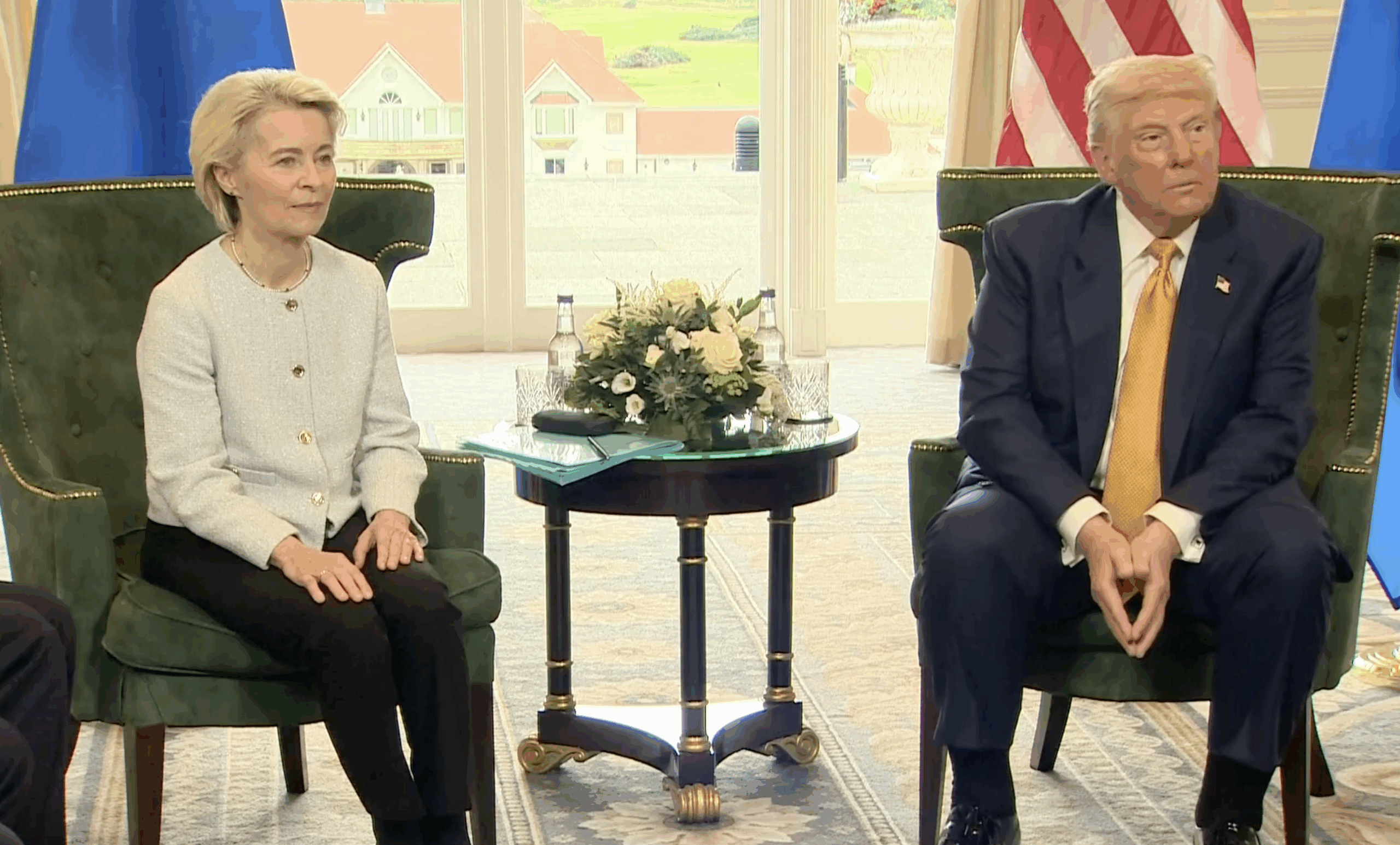This update was written by Maryvonne Maetz of Euros / Agency Group, a BGA partner. Given that this is the largest trade deal U.S. President Donald Trump has signed to date, it has important implications for global trade that bear watching among BGA’s clients in the Indo-Pacific.
Context
- European Commission President Ursula von der Leyen and U.S. President Donald Trump on July 27 finally agreed a political deal on tariffs and trade after months of back-and-forth tariff and retaliation threats. The deal outlines key parameters for the future of trade between the two markets, but the European Union and United States are expected to continue the process to cover additional areas and to improve market access. In its press release, the European Commission highlighted the importance of the transatlantic partnership as a key artery of global trade, with EU-U.S. trade in goods and services doubling over the last decade and surpassing EUR 1.6 trillion ($1.8 trillion) in 2024.
- This deal establishes a single, all-inclusive U.S. tariff ceiling of 15 percent for EU goods. Starting August 1, the United States will apply a maximum 15 percent tariff on the vast majority of EU exports, except when the U.S. most-favored nation (MFN) tariff exceeds 15 percent, in which case only the MFN tariff applies with no additional tariffs added. This rate includes the U.S. MFN tariff rate. The ceiling applies to EU exports currently subject to reciprocal tariffs, to cars and car parts (replacing the U.S. Section 232 tariffs) and any potential future tariffs on pharmaceuticals and semiconductors, including those based on Section 232.
- This deal also provides special treatment for strategic products and protects the steel, aluminum and copper sectors from unfair and distortive competition. Starting August 1, U.S. tariffs on EU aircraft and aircraft parts, certain chemicals, certain generic drugs and natural resources will revert to 2024 levels. The EU and United States agreed to add more products to the list. Together, the EU and the United States will establish tariff rate quotas for EU exports, cutting the current 50 percent tariff rate. The quota has not been set yet.
- The two partners also agreed to liberalize trade that is of mutual interest from the United States into the EU, ensure reliable access to critical energy and future-oriented supplies, and promote mutual investment on both sides of the Atlantic. The EU agreed to eliminate some already low duties on industrial goods. The list has yet to be determined. The EU agreed to further open its markets to U.S. fishery and agricultural products, including Alaska pollock, Pacific salmon, shrimp, soybean oil, planting seeds, grains or nuts and foods such as tomato ketchup, cocoa and cookies. EU companies have expressed interest in investing at least $600 billion in various U.S. sectors by 2029, boosting the already significant EUR 2.4 trillion ($2.8 trillion) in existing investment.
Significance
- A concerning point about this deal is that the EU press release and the U.S. fact sheet seem to contradict each other on some key aspects of the agreement. The two sides did not hammer out a written agreement on specifics as is common in trade agreements, so it is quite possible there will be disagreements on what exactly was promised by the different parties. This is notably the case for pharmaceuticals. The commission indicated that pharmaceutical and semiconductor exports from the EU will remain duty free until Section 232 investigations are completed. However, the White House fact sheet mentions that the 15 percent rate would already apply to EU exports to the United States. For sectoral tariffs on steel, aluminum and copper, the EU press release says the two sides will negotiate a quota and that the U.S. 50 percent tariff would only apply to quantities above the quota. However, from the U.S. side, it seems that the EU will continue to pay 50 percent tariffs on all imports in this category.
- Regarding EU investments in the United States, the EU clarified that it is an “intention,” not a “guarantee,” because investments are made by the private sector. However, the United States noted that “the EU will invest $600 billion in the U.S.” Similarly, the EU indicated that there was no deal on the EU buying U.S. defense equipment, contrary to Trump’s understanding. On agrifood trade, the U.S. press release says that the United States and EU will work together to address nontariff barriers, including “streamlining requirements for sanitary certificates for U.S. pork and dairy products.” But the commission said that it made no concessions on food safety rules and that work on nontariff barriers would focus on cooperation on sanitary and phytosanitary measures. The U.S. fact sheet mentions that both sides intend to address unjustified digital trade barriers. But the EU did not mention digital trade barriers and did not make such commitments in the deal.
Implications
- The announcement of the agreement was met with mixed reactions. EU ambassadors were informed of the agreement and met July 28 to discuss the outcome of the negotiations. The commission is trying to shed a positive light on the agreement, with EU trade chief Maroš Šefčovič noting it was “clearly the best deal we could get under very difficult circumstances.” However, many criticisms were expressed. European Parliament Trade Committee Chair Bernd Lange (Progressive Alliance of Socialists and Democrats, Germany) condemned the deal, noting the asymmetry in the agreement and stressing that the European Parliament would ask for clarifications on outstanding questions. Among the EU’s political groups, the European People’s Party was the only one to criticize the imposition of a 15 percent baseline tariff on EU exports to the United States, calling it a violation of World Trade Organization rules and a threat to European industrial competitiveness.
- EU member states also expressed mixed views. Initial reactions from the French government have been largely negative: Benjamin Haddad, minister for European affairs, and Laurent Saint Martin, minister for foreign trade, described the agreement as “unbalanced,” while Prime Minister François Bayrou characterized the day as “somber.” On the other hand, German Chancellor Friedrich Merz and Italian Prime Minister Giorgia Meloni were quick to praise the agreement.
- The European Commission stressed the political agreement is not legally binding. Further negotiations are therefore expected to take place at technical levels in the coming days and weeks. Beyond taking the immediate actions to which they committed, the EU and the United States must follow their relevant internal procedures to fully implement the political agreement. At the EU level, it is still unclear what form this will take. The current understanding is that the commission would like the agreement to take the form of an “autonomous legal instrument.” This would allow the EU to avoid the lengthy procedure of concluding an international trade agreement, which usually takes several years. In parallel, the regulation implementing U.S. countermeasures has yet to be formally suspended, but this is expected to happen before August 6.
We will continue to keep you updated on developments in the EU as they occur. If you have any questions or comments, please contact BGA Head of Research Murray Hiebert at mhiebert@bowergroupasia.com or Euros / Agency Group Account Manager Maryvonne Maetz at maryvonne.maetz@eurosagency.eu.
Best regards,
BGA and EAG

Head of Research
Murray is a top Asia expert and skilled researcher with three decades of experience living and working in Asia. His networks in business, media and government circles are deep and wide-ranging. He is also a senior associate of the Southeast Asia Program at the Center for Strategic and International Studies (CSIS) in Washington, D.C. Earlier he served as deputy director of the program for six years. Prior to joining CSIS, Murray served for five years as senior director for Southeast Asia at the U.S. Chamber of Commerce where he worked with leading American companies, the U.S. government and Southeast Asian ...
Read More


























